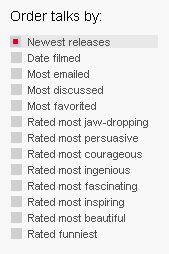
Your archive is all the content that you already have in one form or another that has either been published or remains on some hard drive somewhere. It's easy to think of this content as old and to forget about it. Yet if you look at the TED site, you'll see two dates against each video – one is the date it was recorded and the other is the date it was published publically. Sometimes there are years between those two dates. Here are a few ways that TED makes their archive work for them and how you could too:
- Create evergreen content. The most important element to this planned archiving is to avoid dating your content as much as possible. So don't film it in front of a big sign for an event that says "2004" and choose topics that may be relevant beyond the next few weeks or months.
Enable browsing as well as searching. When you have a great archive, chances are people will stay a while to interact with it. As a result, it's important not just to let them find exactly what they want through search, but also to make it friendly to those just browsing around. Instead of just subject categories or listings by date, TED also takes the smart step of letting you reorder their archive by videos rated by other users to be funniest or most beautiful. The result is that you're likely to spend more time with their content.
- Make your archive portable. One of the fastest growing ways that people can experience the TED content is not through their site at all, but through downloadable videos that you can get from iTunes and put onto your iPod or mobile device. Each piece of content is self contained and is supported by a relatively unobtrusive advertising message added to the end of the video. It remains one of the most popular Podcast programs on iTunes.
- Give people a sense of exclusivity. The conference itself is the epitome of exclusivity (though they are very clear to point out that it's not "elitist" and that all kinds of people have a fair shot to attend). Not only do you have to apply to be accepted to participate, once you are you will need to pay $6000 for the privilege of attending. Of course, people do it because of the quality of the event and the others who are participating (those ranging from rock stars like Bono to world leaders like Bill Clinton, to authors like Malcolm Gladwell). You may not be able to afford a spot, but the perception that you can at least be part of the event by watching or downloading the videos after the event.
Finally, one thing I'm particularly excited about this year is that TED will have a live Twitter feed and more ways to experience the event as it happens beyond just the archive. I'm thinking about putting in my application for the 2010 event already …







WE RECENTLY REMOVED COMMENTING - LEARN WHY HERE >